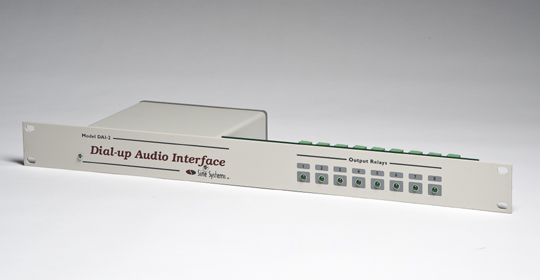Model DAI-2

DAI-2 Dialup Audio Interface
Click image for more views
Features
Dialup Audio Interface
The DAI-2 is a tightly integrated set of subsystems that can be programmed fill a wide variety of broadcast studio needs. Commonly the device is used to perform unattended remote broadcasts for special events or in emergency situations. The flexibility of the system allows it to be tailored to the needs of the individual installation.
System Includes
- 1 ganged DPDT relay for stereo audio switching
- 7 DPDT relays for audio switching and control
- 4 logic-level status inputs
- 3 factory-programmed command sets
- 1 fully user-programmable command set
- Front panel relay status indicators
- Momentary or latched relay operation
- Telephone line audio input and output
- Balanced audio input and output
- Phone line auto-coupler and DTMF tone decoder
- Pluggable screw-terminal connectors for all I/O
- Control unit and relay panel in a single race space
Remote Broadcasts
The DAI-2 can be used to perform a remote broadcast from an ordinary telephone with no assistance from the studio. All it takes is a phone call and a few button presses to connect to the DAI-2, break the audio feed and insert live audio from the telephone into the stream. When the broadcast is complete, press another button to return to normal programming then disconnect. A remote broadcast is that simple.
To ease installation, the DAI-2 has three pre-assigned command sets with suggested wiring diagrams. The wiring diagrams are merely suggestions and many customers use the DAI-2 right out of the box substituting their own wiring with the factory command set. If the default commands do not suit the installation, the unit is fully programmable. You can specify what should happen for each telephone key.
At the press of a button the DAI can:
- Open or close any or all of the audio/control relays
- Route audio from one or more external sources to the telephone line
- Route audio from the telephone line to one or more destinations
- Report the status of logic inputs
The DAI can also monitor the logic inputs and perform tasks based on a status change of the input signals. Logic inputs can cause the DAI to:
- Call up to four telephone numbers to report an alarm condition
- Open or close any or all of the audio switching/control relays
Automatic Behavior
Using the logic inputs the DAI-2 can respond to events automatically. This can be useful for stations that are unattended overnight.
For example, suppose one of the DAI-2 status inputs is connected to an EAS receiver. Under normal conditions, program audio passes through the DAI-2 relays untouched. When the EAS receiver triggers the DAI-2 status input, the DAI-2 can automatically switch the relays to insert audio from the EAS receiver in the program stream. Then the DAI-2 can call a telephone number and send the audio down the telephone line so that when station personnel receive the call they are aware of what is happening.
This is only one example. You may come up with entirely different applications.
Interoperable
When it answers a call, the DAI-2 requires a security code to be given before access to the system is allowed. This allows it to share a telephone line with other devices such as Sine Systems RFC-1 Remote Facilities Controller. Both devices can answer the line on the same ring but, when programmed with different security codes, one device will stay online and the other will disconnect.
Any of the commonly used bandwidth extenders (such as Comrex) can be used with the DAI. In fact, the control capabilities of the DAI can be used to enable and disable the bandwidth extender. The DTMF control tones must be inserted in the system so they will arrive at the DAI at the correct frequencies.
System and Accessories
The DAI-2 system consists of the controller and an integrated relay panel. The controller provides the telephone line interface, tone and logic detection, and audio I/O. The relay panel is the interface to all outboard equipment. All relay panel connections are made with pluggable screw-terminal connections for easy installation and maintenance. The system is a small, elegant and very flexible
CIM-1 Composite Insertion Module
Typically the DAI-2 is installed in the audio chain at the studio site. In some instances installation at the transmitter site is preferred. A composite FM signal can be routed through the CIM-1. Under normal conditions when the CIM-1 is not active it acts like a straight wire. When the CIM-1 is activated by the DAI, an external audio signal is inserted into the air chain. The CIM-1 contains a soft-clipping circuit and a level control to avoid overloading downstream equipment. Connections are made through BNC connectors and screw terminals. The CIM-1 is housed in a small, metal chassis.
DB-1 Delay Board
In normal operation the DAI mutes the audio output whenever a telephone key press is detected. However, it takes about 40 milliseconds to detect and validate the DTMF tone so 40 milliseconds of the tone pass through to the audio output. The DB-1 delays audio through the system so that the audio mutes before the tones reach the output. This prevents DTMF control tones from reaching the air.
If an announcer is monitoring the air feed and the DB-1 is installed, audio will be delayed by about 50 milliseconds. To some announcers this is little more than a minor annoyance but others find it troublesome. The DB-1 can be defeated by system programming.
